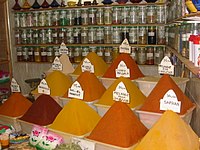Spice
From Wikipedia, the free encyclopedia


A spice is a dried seed, fruit, root, bark, leaf, or vegetative substance used in nutritionally insignificant quantities as a food additive for the purpose of flavor, color, or as a preservative that kills harmful bacteria or prevents their growth.[1]
Many of these substances are also used for other purposes, such as medicine, religious rituals, cosmetics, perfumery or eating as vegetables. For example, turmeric is also used as a preservative; licorice as a medicine; garlic as a vegetable. In some cases they are referred to by different terms.
In the kitchen, spices are distinguished from herbs, which are leafy, green plant parts used for flavoring purposes. Herbs, such as basil or oregano, may be used fresh, and are commonly chopped into smaller pieces. Spices, however, are dried and often ground or grated into a powder. Small seeds, such as fennel and mustard seeds, are used both whole and in powder form.
Contents |
[edit] Classification and types
Spices can be grouped as:
- Dried fruits or seeds, such as fennel, mustard, and black pepper.
- Arils, such as mace.
- Barks, such as cinnamon and cassia.
- Dried buds, such as cloves.
- Stamens, such as saffron.
- Roots and rhizomes, such as turmeric, ginger and galingale.
- Resins, such as asa foetida
Herbs, such as bay, basil, and thyme are not, strictly speaking, spices, although they have similar uses in flavouring food. The same can be said of vegetables such as onions and garlic.
[edit] Early history
The earliest evidence of the use of spice by man was around 50,000 B.C. The spice trade developed throughout the Middle East in around 2000 BC with cinnamon, Indonesian cinnamon and pepper. The Egyptians used herbs for embalming and their need for exotic herbs helped stimulate world trade. In fact, the word spice comes from the same root as species, meaning kinds of goods. By 1000 BC China and India had a medical system based upon herbs. Early uses were connected with magic, medicine, religion, tradition and preservation[2].
A recent archaeological discovery suggests that the clove, indigenous to the Indonesian island of Ternate in the Maluku Islands, could have been introduced to the Middle East very early on. Digs found a clove burnt onto the floor of a burned down kitchen in the Mesopotamian site of Terqa, in what is now modern-day Syria, dated to 1700 BC [3].
In the story of Genesis, Joseph was sold into slavery by his brothers to spice merchants. In the biblical poem Song of Solomon, the male speaker compares his beloved to many forms of spices. Generally, Egyptian, Chinese, Indian and Mesopotamian sources do not refer to known spices.
In South Asia, nutmeg, which originates from the Banda Islands in the Moluccas, has a Sanskrit name. Sanskrit is the language of the sacred Hindu texts, this shows how old the usage of this spice is in this region. Historians estimate that nutmeg was introduced to Europe in the 6th century BC [4].
The ancient Indian epic of Ramayana mentions cloves. In any case, it is known that the Romans had cloves in the 1st century AD because Pliny the Elder spoke of them in his writings.
Indonesian merchants went around China, India, the Middle East and the east coast of Africa. Arab merchants facilitated the routes through the Middle East and India. This made the city of Alexandria in Egypt the main trading centre for spices because of its port. The most important discovery prior to the European spice trade were the monsoon winds (40 AD). Sailing from Eastern spice growers to Western European consumers gradually replaced the land-locked spice routes once facilitated by the Middle East Arab caravans. [5]
[edit] Middle Ages

Spices were among the most luxurious products available in Europe in the Middle Ages, the most common being black pepper, cinnamon (and the cheaper alternative cassia), cumin, nutmeg, ginger and cloves. They were all imported from plantations in Asia and Africa, which made them extremely expensive. From the 8th until the 15th century, the Republic of Venice had the monopoly on spice trade with the Middle East, and along with it the neighboring Italian city-states. The trade made the region phenomenally rich. It has been estimated that around 1,000 tons of pepper and 1,000 tons of the other common spices were imported into Western Europe each year during the Late Middle Ages. The value of these goods was the equivalent of a yearly supply of grain for 1.5 million people.[6] While pepper was the most common spice, the most exclusive was saffron, used as much for its vivid yellow-red color as for its flavor. Spices that have now fallen into some obscurity include grains of paradise, a relative of cardamom which almost entirely replaced pepper in late medieval north French cooking, long pepper, mace, spikenard, galangal and cubeb. A popular modern-day misconception is that medieval cooks used liberal amounts of spices, particularly black pepper, merely to disguise the taste of spoiled meat. However, a medieval feast was as much a culinary event as it was a display of the host's vast resources and generosity, and as most nobles had a wide selection of fresh or preserved meats, fish or seafood to choose from, the use of ruinously expensive spices on cheap, rotting meat would have made little sense.[7]
[edit] Early modern period
The control of trade routes and the spice-producing regions were the main reasons that Portuguese navigator Vasco da Gama sailed to India in 1499. Spain and Portugal were not happy to pay the high price that Venice demanded for spices. At around the same time, Christopher Columbus returned from the New World, he described to investors the many new, and then unknown, spices available there.
It was Afonso de Albuquerque (1453–1515) who allowed the Portuguese to take control of the sea routes to India. In 1506, he took the island of Socotra in the mouth of the Red Sea and, in 1507, Ormuz in the Persian Gulf. Since becoming the viceroy of the Indies, he took Goa in India in 1510, and Malacca on the Malay peninsula in 1511. The Portuguese could now trade directly with Siam, China and the Moluccas. The Silk Road complemented the Portuguese sea routes, and brought the treasures of the Orient to Europe via Lisbon, including many spices.
With the discovery of the New World came new spices, including allspice, bell and chili peppers, vanilla and that greatest of flavorings, chocolate. Although new settlers brought herbs to North America, before 1750 it was thought that you could not grow plants or trees outside their native habitat. This belief kept the spice trade, with America as a late comer with its new seasonings, profitable well into the 19th century.
In the Caribbean, the island of Grenada is well known for growing and exporting a number of spices including the nutmeg which was introduced to Grenada by the settlers.
[edit] Common spice mixtures
- Garam Masala (India)
- Berbere (Ethiopia and Eritrea)
- Colombo (paprika, cumin, coriander, nutmeg, ginger, black pepper, star anise, cardamom, cloves, mustard grains, saffron)
- Curry powder (Indian-style, used in the West and Japan)
- Five bays
- Five-spice powder (China)
- Herbes de Provence (Southern France)
- Jerk spice (Jamaica)
- Khmeli suneli (Georgia)
- Masalas, including garam masala (India)
- Old Bay Seasoning (United States)
- Panch phoron
- Poultry Seasoning (United States)
- Pumpkin pie spice (United States)
- Quatre épices (France)
- Ras el hanout (Middle East/North Africa)
- Shichimi togarashi (Japan)
- Za'atar (Middle East)
[edit] Production

|
Production in tonnes. Figures 2003-2004 |
|||||
| India | 1 600 000 | 86 % | 1 600 000 | 86 % | |
| China | 99 000 | 5 % | 99 000 | 5 % | |
| Bangladesh | 48 000 | 3 % | 48 000 | 3 % | |
| Pakistan | 45 300 | 2 % | 45 300 | 2 % | |
| Nepal | 15 500 | 1 % | 15 500 | 1 % | |
| Other countries | 60 900 | 3 % | 60 910 | 3 % | |
| Total | 1 868 700 | 100 % | 1 868 710 | 100 % | |
[edit] References
- ^ "Food Bacteria-Spice Survey Shows Why Some Cultures Like It Hot". ScienceDaily. March 5, 1998. http://www.sciencedaily.com/releases/1998/03/980305053307.htm.
- ^ A Busy Cook's Guide to Spices by Linda Murdock (pp.14)
- ^ Buccellati et Buccellati (1983)
- ^ Burkill (1966)
- ^ A Busy Cook's Guide to Spices by Linda Murdock (pp.14)
- ^ Adamson, p. 65
- ^ Scully, pp. 84-86.
[edit] Further reading
- Turner, Jack (2004). Spice: The History of a Temptation. Knopf. ISBN 0-375-40721-9.
- "Food Bacteria-Spice Survey Shows Why Some Cultures Like It Hot". http://www.sciencedaily.com/releases/1998/03/980305053307.htm. Retrieved on 2008-12-20. "...Garlic, onion, allspice and oregano, for example, were found to be the best all-around bacteria killers (they kill everything)"
- Sallam, Kh.I.; Ishioroshi, M; Samejimab, K.. Antioxidant and antimicrobial effects of garlic in chicken sausage.
- Billing, Jennifer; Sherman, Paul W. (March 1998). "Antimicrobial Functions of Spices: Why Some Like it Hot". The Quarterly Review of Biology 73 (1). doi:.
- "Common Kitchen Spices Kill E. Coli O157:H7". 18 August 1998. http://www.oznet.ksu.edu/pr_fsaf/News%20Releases/relspicfung.htm. "...The study is the first in the United States that looks at the effect of common spices on E. coli O157:H7. Previous studies have concluded spices kill other foodborne pathogens. 'In the first part of our study, we tested 23 spices against E. coli O157:H7 in the laboratory', Fung said. 'We found that several spices are good at killing this strain of E. coli.'"
- "The Lure and Lore of Spices". http://www.thespicehouse.com/info/lore/. "If the appearance of spices were to reflect their real importance in the history of the world, the bottles of spices would be filled with bright glittery substances, diamonds, rubies, emeralds or gold would be appropriate. When you opened the bottle, a poof of vibrantly colored, mystically fragrant, magical smoke would slowly billow softly throughout the room."
- "Spice". Encyclopedia of Spices, Spice Blends by Region, The Spice Trade. http://www.theepicentre.com/Spices/spiceref.html. Retrieved on 2008-12-20.
[edit] Sources
- Adamson, Melitta Weiss (2004), Food in Medieval Times. ISBN 0-313-32147-7.
- Scully, Terence (1995), The Art of Cookery in the Middle Ages. ISBN 0-85115-611-8.
[edit] See also
| Wikibooks Cookbook has a recipe/module on |
| Look up spice in Wiktionary, the free dictionary. |
| Wikimedia Commons has media related to: Spice |
|
|||||||||||||||||




